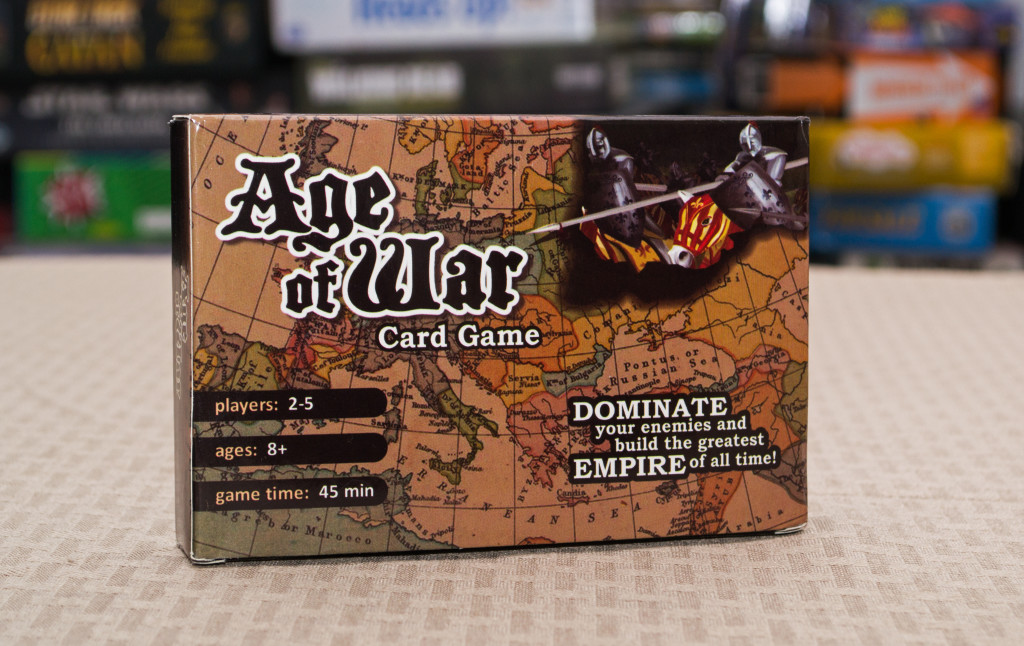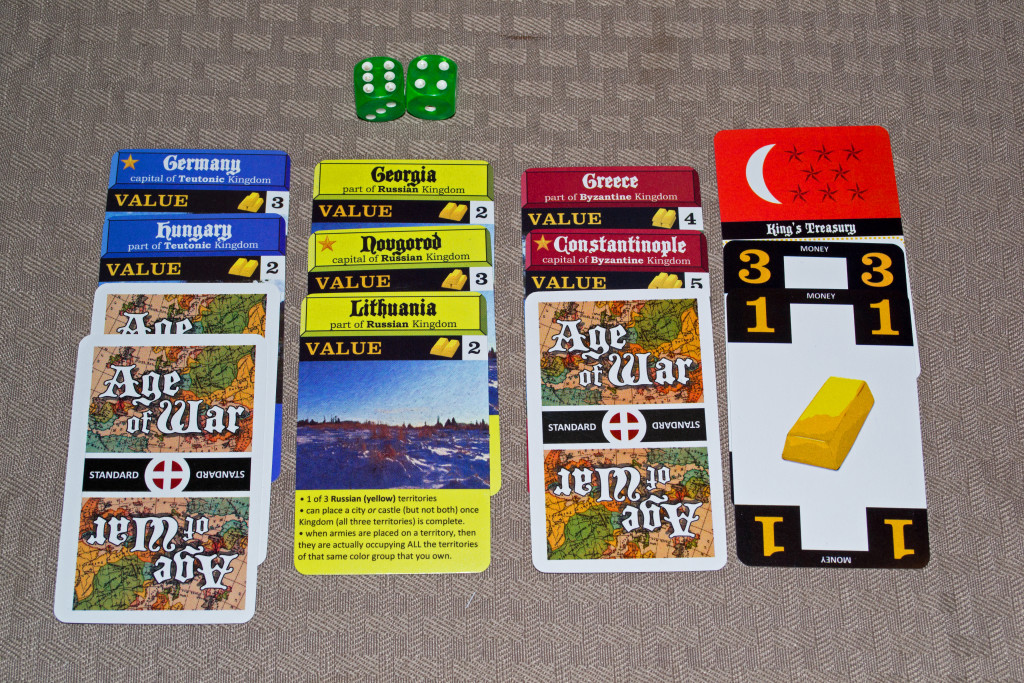Back in the day (presumably when the dinosaurs roamed the Earth), I was big on deep and in-depth PC strategy games like “Medieval: Total War” and “Galactic Civilizations”. I still play them from time to time, mainly due to how convenient it is to have the computer do all the number crunching for you. I couldn’t imagine finding the time I’d need to play something complex like the aforementioned games on my dining room table. Luckily, “Age of War” arrived to save the day, courtesy of Scott Youmans via Battle Born Games. It advertises itself as a “grand-strategic war game” that is “easy-to-learn and quick to play” and to that end, we’re here today to see if that is truly the case.
Components
The game includes 118 cards (72 Standard, 24 Territory, 12 Elite, 5 Flag/Treasury, 5 Quick Reference) and two six-sided dice.
Setup & Gameplay
Each player will take a flag/treasury card and quick reference card. Next, they’ll separate the rest of the cards into three decks: the standard deck, the territory deck, and the elite deck. Five standard cards and one territory card are then dealt face-down to each player. Finally, the three decks are placed into the center of the table within easy reach of players.
The game is played out over a series of rounds, with each player taking turns in clockwise order. A player’s turn consists of the following:
1. Draw Cards – The player will draw one card from the standard pile and one card from the territory pile, placing them into their hand. Once the territory pile is gone, players will instead draw two cards from the standard pile.
2. Take up to Three Actions – The player may play a card onto the table, launch an attack against an enemy, or upgrade a castle or city. A player must always play at least one territory card from their hand if they have one.
3. Move One Army Unit (optional) – The player may transfer an army card from one territory to another within their own empire (think “Risk”). The territories do not have to connect to each other.
4. End Turn – The player must discard down to six cards, discarding only the standard cards. If they have no cards left, they get to draw six standard cards.
The goal of the game is to be the first player to acquire so many kingdoms…that is, three territories of the same color (think “Monopoly”). The number of kingdoms required to win all depends on how many people are playing the game. For example, six kingdoms are required to win in a two player game whereas four kingdoms are required to win in a five player game.
Note: The above doesn’t cover all of the rules found in the manual, but should give you the general idea as to how the game is played. For more information, you can download the manual here:
http://www.ageofwarcardgame.com/uploads/2/5/3/1/25319173/instructions_-_age_of_war.pdf
The Review
The process of turning a complex 4X (“eXplore, eXpand, eXploit, and eXterminate”) war game into a card game that can be played in under an hour is a rather difficult one, I’d imagine. After all, you would be forced to turn some of the more complex gameplay mechanics into something a bit simpler and dumbed-down. The combat, for example, operates on a “Rock-Paper-Scissors” basis…that is, both players will draw the top card from their army deck (at that specific location) and resolve the battle automatically. You could have more armies than your enemy, for example, but it’s very possible that they’ll have a counter to everything you’re throwing at them. Luckily, both players get to organize their draw deck before every round of combat so after a round or two, you can get a feel of what survivors your opponent has left and reorder your own deck appropriately. I’m not too crazy about a “Rock-Paper-Scissors” battle system in general, but I’m not exactly sure how else I’d design it in order to keep the game’s play time forty-five minutes long.
One of the things I really enjoyed was upgrading, which is possible by spending any currency you might have in your treasury (currency enters your treasury via the “play a card” action). Metropolis upgrades allow you to draw an extra card (plus the extra action already allowed by a city), while citadels allow you to draw one extra elite army card to start each turn. Being able to customize my kingdom is what really pulls me in when playing 4X war games…sometimes I’m an economic powerhouse and other times I simply enjoy stomp-rolling everyone that happens to cross my path. Other cards can be used to force your opponent to pay you money and if they don’t have enough, they may have no choice but to simply give you territory. This whole concept reminds me a bit of the card game “Monopoly Deal”, albeit a bit more complex and in-depth. To that end, I honestly believe that the territory management aspects of the game is indeed its best feature.
There’s plenty more to talk about (princess cards, crusade cards, catapult cards, royal guard cards, etc.) but I’ll simply opt to conclude this review by saying that “Age of War” has a lot of variety to it despite the fact that it can be played in under an hour. The backbone of the game is relatively simple (acquire as much territory as possible to create sets), but the act of getting there is really where the game shines. I was surprised by how well all of the different gameplay mechanics came together despite the fact that they were borrowed from other games of completely different genres (“Monopoly Deal” and “Medieval: Total War”, for example). There are a lot of mechanics being thrown at you all at once, so be sure to reserve some extra play time until you get a handle on how everything comes together. For this reason, parental supervision may also be advised (assuming you care if your kids are playing the game correctly).
In short, “Age of War” offers a lot to the casual and hardcore war gamer alike and is relatively family-friendly to boot. The price tag advertised on the official website ($7.95 as of 12/22/14) is more than worth the content being delivered here.
Final Verdict: 9/10
—
You can learn more about and purchase “Age of War” by visiting the official website, here:


